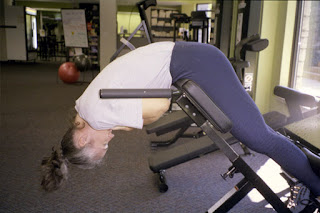More Thoughts on Back Health
 I cringe when I see this. Those who advocate development of paraspinal and erector muscle mass promote doing so with exercises like this. If you understand anything about the spine--if you've read any Stuart McGill--you'll realize that repeated spinal flexion and extension, over time, is risky. The spine is not a hip, knee or even a shoulder. The musculature around the spine is designed for postural control, not ballistic, concentric force production. Hip and leg musculature is.
I cringe when I see this. Those who advocate development of paraspinal and erector muscle mass promote doing so with exercises like this. If you understand anything about the spine--if you've read any Stuart McGill--you'll realize that repeated spinal flexion and extension, over time, is risky. The spine is not a hip, knee or even a shoulder. The musculature around the spine is designed for postural control, not ballistic, concentric force production. Hip and leg musculature is.For performance and health, we want to develop the ability to stabilize the spine and transfer force through the torso, from the ground up. The force is produced and absorbed primarily by the lower extremities. Best movement practices in training, then, teach the athlete to distinguish hip flexion/extension from spine flexion/extension and incorporate the principles of using the hip vs the back during training, life and sport. Now I understand that many tasks don't allow us to use perfect body mechanics and that there will be lumbar flexion and extension with many sport and life movements. However, it is unnecessary and unwise to train loaded and repeated lumbar flexion and extension in order to prepare for those situations.
It's kinda like smoking. Yes, there will be some who survive--maybe even thrive--doing rounded back DLs, wacky ballistic glute-ham stuff, thousands of back (not hip) extensions, etc. But my bet is they are the exception and not the rule. Each body handles stress a little differently. And it is the cumulative stress--the insidious degeneration over time--that gets most of us. Most people don't appreciate good back health, or joint health in general, until it is gone. You don't have to be one of those people.
A better bet is to optimize lower extremity mobility, strength and power while developing sound, efficient movement skills specific to your sport and life tasks. Optimize and apply quality stress to the spine, not maximal stress. This requires understanding and appreciating the difference between spine and hip mobility with sagittal plane movements.

Comments
Can you give me some examples of what you might use, with whom and why?
I forget about that end of the spectrum, as I tend to work mostly with the usual team sport suspects.
Katie
I agree; I think he could go further in his books--not sure what the second ed of his latest book says. I don't know if he has in his talks. This is something I will address in my talk at the NSCA--most specifically with LE based CK movement. The UEs do come into play with certain sports. It is all about context of the movement.
-tcf
I like the GM and SLDL. Everyone should learn the movement; not everyone is ready for barbell loading. Some respond to the SLDL better than the GM. If I had to pick, I would say the SLDL is preferential to use with more people than GMs. It really depends on how advanced the person is.
-tcf
Yes, I'm mostly talking about young athletes; and certainly not experienced fighters or strong men. My goal is to build a good foundation of mobility/stability/strength and body awareness with good torso positioning for the novice and basic hs/college/masters athlete.
If an advanced athlete with sport-specific training demands--grappling--then you can be very creative like Greg is and do some specific advanced torso work. Obviously, the goal is make the athlete as adept and capable as possible, while limiting the amount of direct stress in training. Optimal stress, not maximal.
-TCF
I teach the Waiter's Bow and 45 deg hip extension as a beginning GM/SLDL movement. Whether or not we move on from there, depends on the athlete's needs and abilities.
-TCF